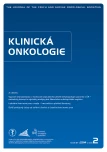-
Články
- Vzdělávání
- Časopisy
Top články
Nové číslo
- Témata
- Kongresy
- Videa
- Podcasty
Nové podcasty
Reklama- Kariéra
Doporučené pozice
Reklama- Praxe
Continuing Progress in Withdrawal of Axillary Dissection in Early Stage Breast Cancer
Authors: D. Vrána 1,2; J. Gatěk 3,4
; K. Cwiertka 1; V. Šrámek 1
Authors place of work: Onkologická klinika LF UP a FN Olomouc2 Oddělení toxikogenomiky, Centrum toxikologie a zdravotní bezpečnosti, Státní zdravotní ústav, Praha 3 Chirurgické oddělení, Nemocnice Atlas, Zlín4 Fakulta humanitních studií, Univerzita T. Bati ve Zlíně 1
Published in the journal: Klin Onkol 2014; 27(2): 143-145
Category: Sdělení
Summary
For a long period of time, axillary dissection represented a standard approach for axillary node management in the case of sentinel node biopsy positivity during early stage breast cancer treatment. In recent years, there has been a trend to highlight the morbidity of such an axillary procedure considering long‑term survival of early stage breast cancer patients. Two big trials, AMAROS and Z0011, were initiated to answer the question whether axillary dissection should be performed in the case of positivity of axillary sentinel node considering the fact that more than 70% of these patients will have no metastasis found during the axillary dissection and such a procedure only increases the morbidity of the surgery. Considering the results of the above mentioned trials, axillary dissection may be avoided in the case of fulfilling of inclusion criteria of these trials without any impact on the patient survival. IBCSG 23 – 01 study brought similar conclusion in the case of micrometastasis in axillary sentinel node.
Key words:
axillary dissection – breast cancer – radiotherapy – breast-conserving surgery
Zdroje
1. Veronesi U, Paganelli G, Galimberti V et al. Sentinel ‑ node biopsy to avoid axillary dissection in breast cancer with clinically negative lymph ‑ nodes. Lancet 1997; 349(9069): 1864 – 1867.
2. Giuliano AE, Hunt KK, Ballman KV et al. Axillary dissection vs. no axillary dissection in women with invasive breast cancer and sentinel node metastasis. JAMA 2011; 305(6): 569 – 575. doi: 10.1001/ jama.2011.90.
3. Sabel SM. Re ‑ evaluating the use of ALND in the context of Z0011. Breast Cancer Symposium 2013.
4. Harbeck N, Thomssen C, Gnant M. St. Gallen 2013: brief preliminary summary of the consensus discussion. Breast Care (Basel) 2013; 8(2): 102 – 109. doi: 10.1159/ 000351193.
5. Eortc.org [homepage on the Internet]. EORTC – The future of cancer therapy. Available from: / / www.eortc.org/ news/ eortc ‑ study ‑ shows ‑ radiotherapy ‑ and ‑ surgery ‑ provide ‑ excellent ‑ regional ‑ control ‑ breast ‑ cancer ‑ pat.
6. Galimberti V, Cole BF, Zurrida S et al. Axillary dissection versus no axillary dissection in patients with sentinel ‑ node micrometastases (IBCSG 23 – 01): a phase 3 randomised controlled trial. Lancet Oncol 2013; 14(4): 297 – 305. doi: 10.1016/ S1470 - 2045(13)70035 - 4.
Štítky
Dětská onkologie Chirurgie všeobecná Onkologie
Článek vyšel v časopiseKlinická onkologie
Nejčtenější tento týden
2014 Číslo 2- Metamizol jako analgetikum první volby: kdy, pro koho, jak a proč?
- Jak souvisí postcovidový syndrom s poškozením mozku?
- Globální doporučené postupy pro léčbu mukormykózy zdůrazňují urgentnost zásahu
- Jak na správnou léčbu omrzlin?
- Perorální antivirotika jako vysoce efektivní nástroj prevence hospitalizací kvůli COVID-19 − otázky a odpovědi pro praxi
-
Všechny články tohoto čísla
- Aplikace poznatků psychoneuroimunologie v kontextu komplexní onkologické léčby karcinomu prsu
- Mamografický screening u brazilských žen z hlediska socio‑ ekonomické stratifikace
- Léčba anakinrou u Schnitzler‑ syndromu – výsledky první retrospektivní multicentrické studie šesti pacientů z České republiky
- Význam standardizace v hodnocení populačního přežití onkologických pacientů v ČR – metodický koncept a výsledky analýzy dat Národního onkologického registru
- Adenokarcinóm rete testis – zriedkavý prípad testikulárnej malignity
- Informace z České onkologické společnosti
- Renálny onkocytóm s histologickými črtami invázie – kazuistika
- Další postupný ústup od axilární disekce u časného karcinomu prsu
- Zajímavé případy z nutriční péče v onkologii
- Massive Cutaneous Metastasis of a Renal Cell Carcinoma
- Soutěž o nejlepší práci
- Editorial
- Role mikroRNA v molekulární patologii karcinomu jícnu a jejich potenciální využití v klinické onkologii
- Lobulární karcinom prsu u muže – kazuistika a přehled literatury
- Klinická onkologie
- Archiv čísel
- Aktuální číslo
- Informace o časopisu
Nejčtenější v tomto čísle- Aplikace poznatků psychoneuroimunologie v kontextu komplexní onkologické léčby karcinomu prsu
- Renálny onkocytóm s histologickými črtami invázie – kazuistika
- Další postupný ústup od axilární disekce u časného karcinomu prsu
- Lobulární karcinom prsu u muže – kazuistika a přehled literatury
Kurzy
Zvyšte si kvalifikaci online z pohodlí domova
Autoři: prof. MUDr. Vladimír Palička, CSc., Dr.h.c., doc. MUDr. Václav Vyskočil, Ph.D., MUDr. Petr Kasalický, CSc., MUDr. Jan Rosa, Ing. Pavel Havlík, Ing. Jan Adam, Hana Hejnová, DiS., Jana Křenková
Autoři: MUDr. Irena Krčmová, CSc.
Autoři: MDDr. Eleonóra Ivančová, PhD., MHA
Autoři: prof. MUDr. Eva Kubala Havrdová, DrSc.
Všechny kurzyPřihlášení#ADS_BOTTOM_SCRIPTS#Zapomenuté hesloZadejte e-mailovou adresu, se kterou jste vytvářel(a) účet, budou Vám na ni zaslány informace k nastavení nového hesla.
- Vzdělávání



